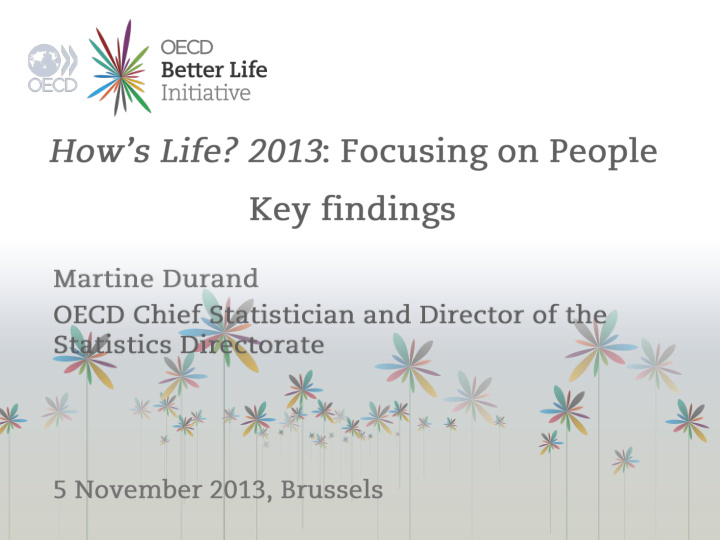



Australia Canada Denmark Norway Top 20% performers Sweden Switzerland United States Czech Austria Belgium Finland France Republic Germany Iceland Ireland Israel Italy 60% middle performers New Japan Korea Luxembourg Netherlands Zealand Slovak United Poland Slovenia Spain Republic Kingdom Chile Estonia Greece Hungary 20% bottom performers Mexico Portugal Turkey Source: How’s Life? 2013 – Unweighted averages across all well-being dimensions
20% top performers 60% middle performers 20% bottom performers Canada Germany Greece
United States OECD Euro area (selected countries) Life satisfaction Life satisfaction Long-term unemployment rate (right hand y-axis) Long-term unemployment rate (right hand y-axis) 7.6 3 7.6 7 7.5 7.4 6 3 7.2 7.4 5 7.0 7.3 2 6.8 7.2 4 2 6.6 7.1 3 6.4 7.0 1 6.2 2 6.9 6.0 1 1 6.8 5.8 6.7 5.6 0 0 2007 2008 2009 2010 2011 2012 2007 2008 2009 2010 2011 2012 Source: How’s Life? 2013 X-axis: Life Satisfaction =average score on a 0-10 scale ; source: OECD calculations on the World Gallup Poll Y-axis: Long term unemployment rate= % of the labour force unemployed for one year or more; source: OECD Labour Force Statistics
Around 20% of US households OECD Euro Area, 2007 = 100 moved in with other households Household disposable income per capita GDP per capita 102 In the Euro area, the share of the population with total housing costs 100 greater or equal to 40% of disposable income rose 98 Owner with mortgage or loan 10 96 9 94 8 92 7 90 6 2007 2008 2009 2010 2011 2012 5 2007 2008 2009 2010 2011 Source: OECD National Accounts Database Source: OECD calculations on US SIPP and EU-SILC
Percentage of people reporting Percentage of people reporting having helped to trust national government someone, 2007=100 OECD OECD Euro area OECD OECD Euro area USA JPN USA 55 120 50 115 45 110 40 105 35 100 30 95 25 90 20 15 85 10 80 2007 2008 2009 2010 2011 2012 2007 2008 2009 2010 2011 2012 Source: OECD calculations on Gallup World Poll
OECD Euro area employment rates of different Percentage of people reporting unmet medical groups relative to that of the overall population needs for financial reasons 2008 Q1=100 Youth (aged 15/16-24) OECD Europe GRC ITA FRA Older workers (aged 55-64) Low-skilled (aged 25-64) 7 High-skilled (aged 25-64) 120 6 5 110 4 100 3 2 90 1 80 0 2007 2008 2009 2010 2011 Source: OECD Labour Force Statistics Source: OECD calculations on EU-SILC
- Work pressure Job Demands - Emotional demands - Physical health risk factors - Workplace intimidation - Work autonomy - Learning opportunities Job Resources - Task clarity - Supportive management practices - Colleagues’ support
Proportion of European workers reporting that Number of annual days of sick leave, work impairs their health, 2010 Europe, 2010 12 50 10 45 40 8 35 30 6 25 20 4 15 10 2 5 0 0 High job High job Low job Low job High job High job Low job Low job demands demands demands demands demands demands demands demands and low job and high job and low job and high job and low job and high job and low job and high job resources resources resources resources resources resources resources resources Source: OECD calculations on the European Survey on Working Conditions
Poverty rates among individuals living in households with at least one worker, 2010 20 18 16 14 12 10 8 6 4 2 0 Source: OECD Income Distribution Database
Gender wage gaps Gender time gaps ( Men minus Women/Men ) (Women minus Men) Number of weekly hours of unpaid work 2010 or latest available year 2000 or first available year 25 50 20 40 15 30 10 20 5 10 0 0 Source: OECD Employment Database Source: OECD calculations based on national time-use surveys
Women are the primary target of intimate violence and have greater fears about their safety On average in the OECD, 25% of women say they have been victim of intimate violence from their partner Women are under-represented in top management and political positions On average in the OECD, only 27% of parliamentary seats are occupied by women Women live 5 years longer than men Young women are more educated than young men
Proportion of men and women relying on partner/spouse and friends if they needed help when looking for a job, Europe, 2007 Partner / spouse Friend 22 20 18 16 14 12 10 Men Women Source: OECD calculations on European Quality of Life Survey
Recommend
More recommend